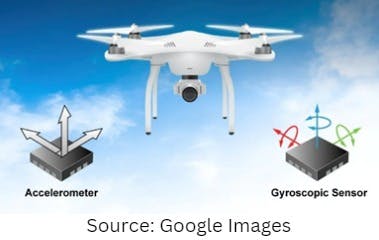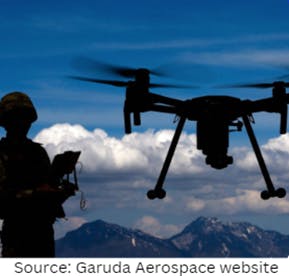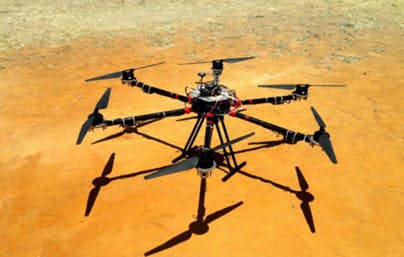Table of contents
No headings in the article.
Drones - a word omnipresent in the technical world that fascinates anyone and everyone, is generally understood to be a remote-controlled flying object that performs simple functions like surveillance, transportation, etc., but the most interesting part of a drone is its working. How does a drone fly? How does it hover around by just moving a joystick? What is obstacle avoidance? This article will help you answer these questions.
A drone is an unmanned vehicle, either controlled by a remote or an autonomous flight control system (via software-embedded systems). Some of the basic parts of a drone are communication systems, speed and flight controllers, GPS modules, batteries, and receivers.
Drones primarily have two functions:
Flight Mode: This includes propellers, rotors, a power source, and a body frame to take off, land, and hover.
Navigation Mode: This deals with drones’ manoeuvre across certain topography, with the assistance of sensors and certain electrical devices.
Flight Mode:
The fundamental physics behind the lift of a drone is torque. Once the propellers are given the necessary force by the motor via the rotors, a pressure difference is created between the top and the bottom surfaces of the propellers. The blades create a downwash which induces a thrust on the rotors. The faster the blades rotate, the greater the thrust applied to the rotor and a greater magnitude of lift is created.
Lift-off!
According to Newton’s third law of motion, every action produces an equal and opposite reaction. Consider the action, in this case, the rotation of propellers. Torque is the rotational equivalent of force that is applied to it, so it produces a torque in the reverse direction back to the rotor. Now based on the number of propellers applying torque, we divide the types of drones into 4 following ones:

Single propeller drones: These drones were the first of their kind, having one propeller attached to the body. This kind of drone can only go upwards and downwards. Now when the propeller/rotor gives equal and opposite torque to the stator, it leads to an undesirable movement of the body. This hampers the stability of the drone and makes navigation tough.
Two propeller drones: This drone has two propellers to increase stability and decrease unwanted rotation of the body. The main idea behind two propellers is to cancel the torque produced on the body. The propellers are made to rotate in opposite directions, one clockwise and one anticlockwise.
Three propeller drones: This is the least used type. In this type, reaction torque is not cancelled out because of the presence of the third propeller. Here the Gyroscopic precision is also not good.
Four propeller drones: These are the most common type. You will notice the positioning of the propellers will make either an H or an X. To overcome the reaction torque, one diagonal pair is spun in opposite direction to the other diagonal pair. This type has the perfect airfoil shape to achieve airlift force.
There are many more types based on the number of propellers like hex copters (six propellers), octocopters (8 propellers), and more. The power source which supplies energy to the motor to rotate the propellers is usually Lithium-ion batteries. While achieving hovering, the weight of the fuselage should be equal to the thrust produced by the propellers. The framework of the fuselage is usually made of lightweight composite material to increase manoeuvrability.
We know that the drone can move forwards, backward, and sideways and perform the yaw movement. All this can be simply done by changing the rotation speeds of the propellers! Let’s take the case of a quadcopter (4 propellers). To achieve forward motion, the front propellers slow down and the rear speeds up, and vice versa for backward motion. To achieve roll, more thrust is applied to a rotor and less to the one opposite to this specific rotor. To achieve yaw motion, the drone applies more thrust to one set of propellers, changing net reaction torque and leading to a high-speed sharp turn.
Navigation Mode:
The drone’s circuitry includes pilot IC chips and drone sensors that use mem technology such as accelerometers, magnetometers, and gyroscopic sensors. They’re all closely integrated into the IMU. IMU is the inertial measurement unit. It allows drones to operate and fly with maximum control and stability. Mem technology is microscale machines with moving parts in their circuits that produce necessary electrical signals to operate the drone. An external stimulus results in a change in orientation and to ensure these stimuli produce reliable output signals, we use the concept of sensor fusion.

In sensor fusion, GPS, IMU, and radar tech work together to make signals accurate and cancel other disturbances like noise and sometimes dust particles too. To further reduce error, the circuity includes control logic which uses various algorithms to make smart decisions to control the speeds of the four BLDC motors and one such algorithm is the Kalman Filter algorithm. This algorithm makes predictions and provides estimations of some unknown variables with the help of measurements made and analysed over time.
Radiofrequency technology is used to navigate the drone. They send radio waves of frequency 2.4 GHz to 2.483 GHz or 5.725GHz to 5.825GHz. Radio waves are used due to their accuracy for long distances.
Additional Features:

This depends on the job of the drone. A drone used as a commodity of defence is equipped with high-resolution cameras, motion detectors, live video feed, thermal detection technology, and many more. One such example is, the “Anti-Drone” made by Garuda Aerospace in collaboration with DRDO. It has laser neutralization systems, gun defence systems, mesh ejection systems, electromagnetic interference systems, radar detection, and more. This drone type is capable of destroying any enemy UAV. Surveillance drones may come with an AI-enabled software system and good cameras.

Here at Team Aviators International, we concentrate more on surveillance drones. Apart from the basic framework, our drone is loaded with a high-quality camera and a good gripping system to carry payloads. Orel, our heavy-lifting hexacopter with a payload of 25kgs, had motors with a combined thrust of 81 KgF. Another one of our creations is an unmanned medical assistance drone that is capable of carrying heavy medical equipment like defibrillators and basic first aid supplements required during an emergency.

Its well-designed autonomous system allows the drone to reach any destination in the predefined vicinity within 10 mins, making it easier to operate and help those in need. In conclusion, drones are unmanned aerial vehicles that can be reformed to perform various tasks by keeping the main body the same and editing the extra features.
Happy learning!
BIBLIOGRAPHY:

